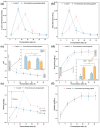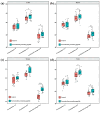Study on the Improvement of Quality Characteristics of Pickles During Fermentation and Storage
- PMID: 39766932
- PMCID: PMC11675974
- DOI: 10.3390/foods13243989
Study on the Improvement of Quality Characteristics of Pickles During Fermentation and Storage
Abstract
This study investigated the effect of fermentation-promoting peptides (FPPs) on the improvement of the quality of cowpea pickles during fermentation and storage. FPPs were introduced to evaluate their effects on key parameters such as pH, total acidity, nitrite levels, and salinity. FPP accelerated fermentation by stimulating lactic acid bacteria (LAB) activity, leading to a rapid reduction in pH and a stable increase in total acidity. Nitrite accumulation was peaking at 0.56 mg/kg on the 7th day, compared to 1.37 mg/kg in the control, thus enhancing product safety. FPP also improved antioxidant retention, reducing ascorbic acid degradation by 30% and increasing phenolic retention by 15.97% over the control, which is essential for antioxidant capacity and color stability. Texture analysis showed higher hardness preservation in the presence of FPP, in which hardness decreased from 209.70 g to 79.98 g in the FPP group after storage, compared to a decline from 158.56 g to 41.66 g in the control. Additionally, sensory evaluations demonstrated that the FPP group maintained superior flavor, texture, and appearance, with minimized browning due to improved pectin stability. This research presents FPPs as a promising additive for producing high-quality, shelf-stable pickles in line with clean label trends.
Keywords: anti-browning and texture retention; cowpea pickle quality; fermentation-promoting peptides.
Conflict of interest statement
The authors declare no conflicts of interest.
Figures




Similar articles
-
Lactiplantibacillus sp. G6 isolated from goose intestine as starter culture for degrading nitrite and improving quality in Chinese pickle fermentation.Food Sci Biotechnol. 2023 Nov 20;33(6):1413-1423. doi: 10.1007/s10068-023-01433-8. eCollection 2024 May. Food Sci Biotechnol. 2023. PMID: 38585556 Free PMC article.
-
Enhancing the Texture and Sensory Properties of Pickled Cucumbers with Different Brine Solutions.Foods. 2025 Jan 21;14(3):336. doi: 10.3390/foods14030336. Foods. 2025. PMID: 39941928 Free PMC article.
-
Effects of a brief blanching process on quality, safety, and shelf life of refrigerated cucumber pickles.J Food Sci. 2022 Apr;87(4):1475-1488. doi: 10.1111/1750-3841.16112. Epub 2022 Mar 15. J Food Sci. 2022. PMID: 35292980
-
Influence of oxygen exposure on fermentation process and sensory qualities of Sichuan pickle (paocai).RSC Adv. 2019 Nov 26;9(66):38520-38530. doi: 10.1039/c9ra05994f. eCollection 2019 Nov 25. RSC Adv. 2019. PMID: 35540217 Free PMC article.
-
Impact of post fermentation cooling patterns on fatty acid profile, lipid oxidation and antioxidant features of cow and buffalo milk set yoghurt.Lipids Health Dis. 2020 Apr 15;19(1):74. doi: 10.1186/s12944-020-01263-1. Lipids Health Dis. 2020. PMID: 32293468 Free PMC article.
Cited by
-
Novel insights into the quality changes and metabolite transfer rules of pickles during fermentation: Pickle versus pickle solution.Food Chem X. 2025 Jan 24;25:102203. doi: 10.1016/j.fochx.2025.102203. eCollection 2025 Jan. Food Chem X. 2025. PMID: 39974520 Free PMC article.
References
-
- Jha P.K., Chapleau N., Meyers P.-E., Pathier D., Le-Bail A. Can cryogenic freezing preserve the quality of fruit matrices during long-term storage compared to the mechanical method? Appl. Food Res. 2024;4:100374. doi: 10.1016/j.afres.2023.100374. - DOI
-
- Bao R., Fan A., Hu X., Liao X., Chen F. Effects of high pressure processing on the quality of pickled radish during refrigerated storage. Innov. Food Sci. Emerg. Technol. 2016;38:206–212. doi: 10.1016/j.ifset.2016.10.009. - DOI
Grants and funding
LinkOut - more resources
Full Text Sources
Miscellaneous

